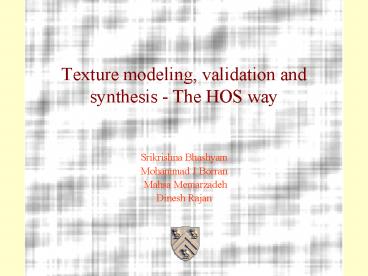Texture modeling, validation and synthesis - The HOS way - PowerPoint PPT Presentation
Title:
Texture modeling, validation and synthesis - The HOS way
Description:
... output system of linear equations. Texture Synthesis. x11. x12 ... M systems of M Linear equations. Texture Synthesis. Causal AR model. Non-causal AR model ... – PowerPoint PPT presentation
Number of Views:37
Avg rating:3.0/5.0
Title: Texture modeling, validation and synthesis - The HOS way
1
Texture modeling, validation and synthesis - The
HOS way
- Srikrishna Bhashyam
- Mohammad J Borran
- Mahsa Memarzadeh
- Dinesh Rajan
2
Key Results
- Textures can be modeled as linear, non-Gaussian,
stationary random field - validated using HOS. - Textures can be synthesized using
- causal / non-causal AR models.
- AR model parameters can be estimated accurately
using HOS.
3
Why Higher Order Statistics?
- Deviations from Gaussianity
- for Gaussian, all higher order spectra (ordergt2)
0 - Non-minimum phase extraction
- unlike power spectrum, true phase is preserved
- Detect and characterize non-linearity
- Applications
- array processing, pattern/signal
classification...
4
What are these Monsters?
- Moments
- Cumulants
- cumulant central moment (order lt 3)
- Gaussian processes, all cumulants are zero (order
gt 2) - Cumulant Spectra
- bispectrum FT order 3 cumulant
Xt
kt1
k
kt2
5
Challenges
- Storage and computation of bispectrum
- 128x128 image
- 4D matrix with 268,435,456 elements (1.07 GB)
- Symmetry gt redundant elements
- factor of 12 reduction
6
Non-redundant Region of Bispectrum
- 6-fold symmetry
- S3x(u, v) S3x(v, u)
- S3x(u, -u-v)
- S3x(-u-v, u)
- S3x(v, -u-v)
- S3x(-u-v, v)
- If x is real (12-fold symmetry)
- S3x(u, v) S3x(-u, -v)
7
2-D ARMA Model
H(z)
w(m, n)
x(m, n)
- Bispectrum
- Bicoherence
- Constant for linear processes
- Zero for Gaussian processes
8
Model Validation Tests
- Gaussianity test
- Statistical test to check if the bicoherence is
zero - Test statistic is chi-squared distributed
National Institute of Agro-Environmental
Sciences, Japan http//ss.niaes.affrc.go.jp/pub/m
iwa/probcalc/chisq/
9
Model Validation Tests
- Linearity test
- Statistical test to check if the bicoherence is
constant - Is the variability of the bicoherence small
enough? - Spatial reversibility test
- Does the texture have any spatial symmetry ?
- Is the imaginary part of bicoherence zero ?
10
Statistical Test Results
Brodatz Textures http//www.ux.his.no/tranden/
brodatz.html
- Linear, non-Gaussian, spatially irreversible
11
Texture Synthesis
- 2-D, non-causal, non-Gaussian, AR model
- Causal AR
- Direct IIR filtering recursive equation
- Non-causal AR
- No recursive equation
- Calculate truncated impulse response
- Solve input-output system of linear equations
12
Texture Synthesis
w11
x11
1
M
M-1
w12
x12
M
1
M
1
2
wMM
xMM
Image size M x M
13
Texture Synthesis
w11
x11
w12
x12
0
0
wMM
xMM
M systems of M Linear equations
14
Texture Synthesis
- Causal AR model
Non-causal AR model
15
Parameter Estimation
- Try to match more than the power spectrum
- Cumulants instead of correlations
- C a c instead of R a r
- Calculate only the cumulants that are needed
16
Parameter Estimation
- AR parameter estimate with 64 x 64 texture
Actual a Estimated a
17
Summary
- Higher-order spectrum basics
- Linearity, Gaussianity and spatial reversibility
- Texture model validation
- 2-D Causal and Non-causal AR models
- Texture synthesis
- Cumulant based causal AR parameter estimation
- Modeling of real textures
- Useful for texture classification and
segmentation - HOS useful but too complex
18
References
- T. E. Hall and G. B. Giannakis, Bispectral
Analysis and Model Validation of Texture Images,
Trans. SP, 1995. - S. Das, Design of Computationally Efficient
Multiuser Detectors for CDMA Systems, M. S.
Thesis, Rice University, 1997. - R. Chellappa and R. L. Kashyap, Texture
Synthesis using 2-D Noncausal Autoregressive
Models, Trans. ASSP, 1985. - A. T. Erdem, A Nonredundant set for the
Bispectrum of 2-D Signals, ICASSP, 1993. - C. L. Nikias and A. P. Petropulu, Higher-order
Spectra Analysis, 1993.































